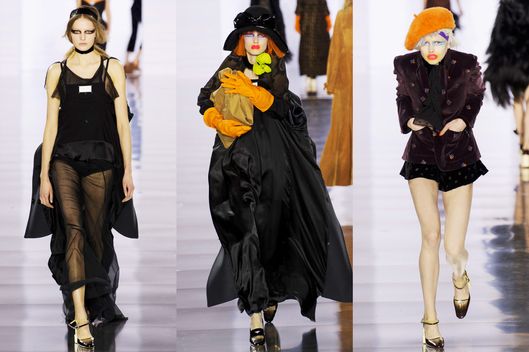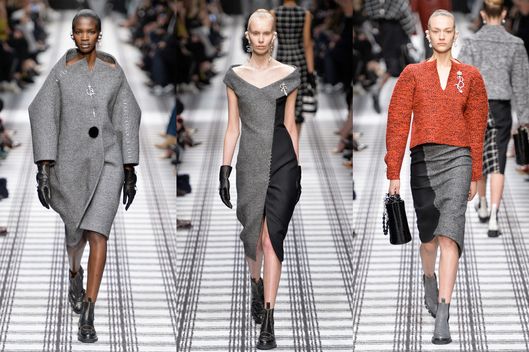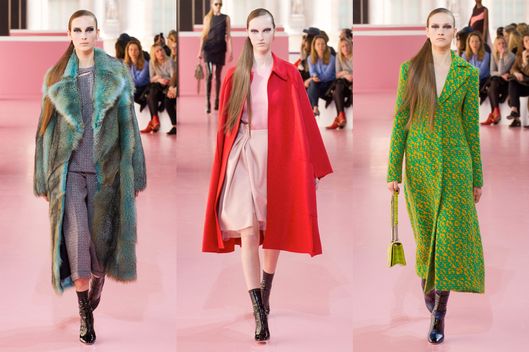Balenciaga
See it »
Dior, Balenciaga, and Margiela were notable examples this weekend.


At the Dior dinner this weekend at Les Bains, the former dance club turned slick hotel, I found myself seated next to a polite, attractive young woman who introduced herself as Ella. When Ella revealed that she wrote songs, I nodded. Maybe I also said something like, “Oh. That’s interesting.” We switched to fashion and Ella observed that many shows look more styled than designed. I agreed, thinking in particular of the latest Balenciaga and Margiela shows, and Ella remarked that she hoped this was just a phase. Sensing she might enjoy a real souvenir of chic à la francaise before she returned home (she mentioned New Zealand), I urged her to see the new Jeanne Lanvin exhibit.
“It will really give you a lift,” I said.
Sometime during the first course, it dawned on me that Ella might be the two-time Grammy winner Lorde. To be sure, I grabbed her place card when she turned her head.
Oh, brother. She was just as polite when I fessed up.
If there is one certainty in fashion, it is that nothing is eternal. I remember asking a Chanel executive ten years ago what she thought would happen to Chanel’s haute couture after Karl Lagerfeld retired. I wondered because Lagerfeld’s knowledge is finite; the skills he acquired in the 1950s and '60s can’t easily be replicated. The executive said, mildly, “It will just evolve into another kind of business.” At the moment, high-fashion companies are obsessed with thinking like mass-media entities. They collect data and give clothes to the so-called "Instagram girls," with their huge followings — and, I hear, some houses even book models based on their social-media presence.
“It doesn’t feel like the luxury business,” said a studio assistant in a major house, who has noticed a marked change in the past year or so. And taking a longer view, back to the 1920s and '30s, the business is scarcely recognizable from what it was in the days of Jeanne Lanvin.
Still, fashion survived and it did so because brands like Chanel and Dior have adapted, however uncomfortably, to the times. In a way, then, I don’t mind the current emphasis on communication over design values. But it would help if people were more clear-eyed — as Ella was — about what we're looking at.

Let’s take John Galliano’s very boring, maiden ready-to-wear collection for Margiela. He did due diligence with the Margiela signatures like deconstructed linings and minimalist coats, but many outfits resorted to Galliano's old styling tricks, like a purple blazer with tap pants and a black chiffon dress layered over a lace catsuit. The models wore clownish makeup, and a few walked in an angry or spastic gait, with one clutching a paper bag as she threw herself down the runway. It was almost comical, as if these models were Galliano women who had been in hiding the past few years and were now free to walk in the light again.
In any case, the mash-up wasn't successful. Galliano isn’t a modernist designer. And Margiela, if it’s anything, is a label with a modern point of view. Few designers are better than Galliano at creating moments of ineffable beauty, which draw on the past as well as the present. But apart from some collections he did for Dior around 2000, he’s never shown much ease with modern concepts. So I was seriously skeptical when, just after the show ended, several retailers praised the collection as "fresh."

Lady Gaga’s campy strut to her seat at Balenciaga, with a video man’s spotlight on her, was a good prelude to Alexander Wang’s near parody of couture glamour. I really enjoyed watching this show. It made a statement — with the models’ smooth caps of hair and the sparkly head-to-toe accessories (among the best Wang's made at Balenciaga yet). And the first ten outfits were engaging, for their raw sophistication, as well as the cut of the tweeds mixed with solid blacks and the nice touch of metal staples on seams. But, again, much of the glamour seemed calculated, endlessly tweaked, and not based on new or surprising ways of using Balenciaga’s design techniques.

At Dior, Raf Simons always focuses on keeping the collection about design and looking modern. The sublime, precise coats with their plain lines, and the palette of browns, pale pinks, amphibian greens, dusky orange, and grays, were unlike anyone else’s this season. The colors were taken from nature, but the pigments, in patterns of dots and stripes, were magnified and often abstracted as well. In the end, they barely suggest the natural world — and indeed they just as easily could have been inspired by Pop Art.
The simple silhouette (in a noisy season) continues themes from Dior's January couture show. Lean, superfine knits and two-piece dresses made of intricately cut patent leather felt almost as fine as mesh. “I think pushing away from the heritage of Dior allows other things to come in,” Simons explained. “Otherwise, you end up always with a pleated full skirt and the Bar jacket. This tailoring is not Bar.”
So it seems, in the hands of a true modernist, even familiar themes can evolve into something unrecognizable and new — something that transcends styling.
To be fair, it was a 13 foot-long dress.
You and Rihanna Will Both Want to Invest in Dior’s New BagIt's got something for everyone.
Polo Shirts Have Turned Their Back on Ryan LochteAlong with his other major sponsors.
Ryan Lochte Will No Longer Be Paid to Wear Tiny Bathing SuitsSpeedo remains committed to transparency.
Laura Brown Is the New Editor-in-Chief of InStyleAfter 11 years at Harper’s Bazaar.
Tyra Banks Is Going to Teach a Class on Smizing at Stanford"If I see somebody not paying attention, I’m gonna call on them."
This Floating Pier Is the Most Zen Installation EverWalking on water in Italy.
Nation Is Appalled by Matt Lauer’s Nude Ankles During Ryan Lochte InterviewWhat’s the opposite of “Jeah”?
8 People at the Life of Pablo Pop-up Explain Why Kanye West Is a God"I mean, Kanye West is just Kanye West. There's not more or less you can say about Kanye West. He's just Mr. West!"
A T-shirt Is EnoughSimplicity, versatility, and cool. What more could you want?
She took a perfect pencil dive off a 30-foot yacht.
American Apparel Is Being Sued by Former WorkersAs the company considers putting itself up for sale.
A Gendered History of the Tailored SuitFrom Marlon Brando to Coco Chanel.
How Zendaya Developed Such Great Style at the Young Age of 19The star's best looks from Disney to now.
Proof That If You’re Chic Enough, a Little Federal Investigation Doesn’t MatterIs this the best they could do?
5,300-Year-Old Mummified Iceman Probably Would’ve Been a Street-Style StarHe had several different looks and was “pretty picky.”
J.Crew Has Identified 226 Shades of PinkEven more than there are shades of gray.
Gigi and Bella Hadid Merch Is Now Somehow a Thing That Is HappeningToday in Hadidiana.
Gird Your Loins for the Return of Yeezy to New York Fashion WeekThe season approaches.
This Indie Brand Had a Great Response to Ivanka TrumpWhen she bought one of their cuffs, they donated the proceeds to the Clinton campaign.